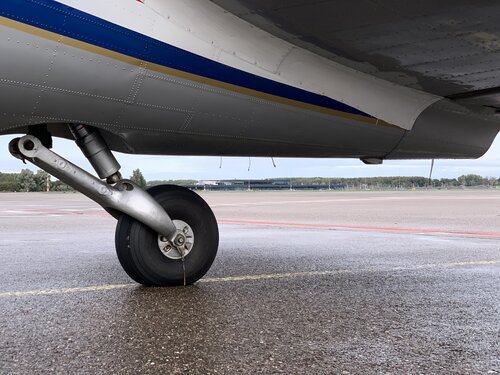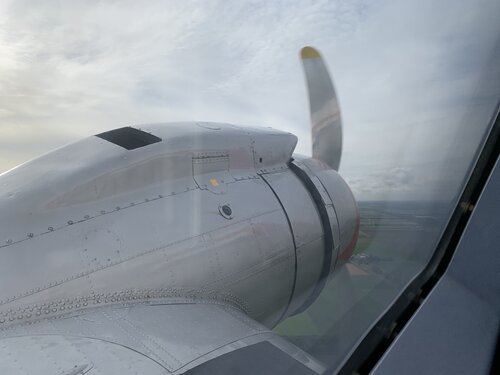Oct. 19, 2019
Flying in a C47-A (DC-3) classic plane
Aboard the 75-year old royal PH-PBA dakota
As a wonderful birthday gift I was honoured to fly in a DC-3 classic plane. It was the 75-year old PH-PBA, a C-47A Skytrain or Dakota, formerly owned by H.R.H. Prince Bernhard from The Netherlands. It's a very special plane operated by the enthusiastic people from the Dutch Dakota Association (DDA Classic Airlines). Read along for some aviation history!
C-47A Skytrain
The C-47 is a military version of the civilian Douglas DC-3. Built by the wonderful ladies known as "Rosie the Riveters", this C-47A Skytrain was built in the Douglas factory in Long Beach, California in 1943. Many women worked on the planes as most men were enlisted to war.

During World War II the C-47 was used by many countries to transport troops, cargo and wounded. More then 10.000 aircraft were produced. In Europe the C-47 was used during D-Day to drop more than 50,000 paratroops.


PH-PBA
The C-47 operated by the Dutch Dakota Association (DDA Classic Airlines) was built in 1943. It was part of the 316th Troop Carrier Group during D-Day where it flew in formation with 35 other C-47's to drop more than 600 paratroopers in dropzone 'O', near St. Mère Église, Normandy, France. During this mission the plane was shot, taking damage but remaining able to return to England. After repairs the plane was involved in many more missions, including operation Market Garden, the Allied attempt to liberate The Netherlands.
In 1946 H.R.H. Prince Bernhard bought the aircraft from General Eisenhower for US $ 50,000. A bargain, he thought, as the aircraft had locked up only 300 flying hours. The aircraft with military markings "42-100971" is registered in the Dutch aviation register as PH-PBA, where PH- being the country code for The Netherlands and PBA is short for "Prince Bernhard Alpha". It became the first Dutch government aircraft.

The plane remained in service until 1975 when it was donated to the Aviodrome museum at Schiphol Airport. For long H.R.H. Prince Bernhard kept a strong wish to restore the airplane to flying conditions. After years of restoration, the plane was ready to fly again in 1998 when the Dutch Dakota Association was granted the right to operate and maintain the PH-PBA.

Flying a classic plane
It's one thing to read about and walk around a piece of aero history, to fly it is sensational! Lucky me, as I got a ticket from my pilot buddy Tim to fly along over the Frisian lakes (Friese Meren) in this special piece of aircraft history.



The PH-PBA is equipped with two Pratt & Whitney R-1830 Twin Wasp aircraft engines. They are two-row, 14-cylinder, air cooled engines producing about 1200 HP. Each engine weighs about 567KG and displaces 30 liters. It requires regular servicing, which is done by the volunteers from the DDA. They are piston engines and that is something special these days: easily distinguishable by their sound!

Although the C47-A is capable of starting its own engines, the PH-PBA is usually started using a generator. As history is full of sweet irony, it's a German built, Deutz diesel powered electrical generator. It's really cool to see this old tech still working fine; it's a welcome contrast to many of the modern day planned obsolescence.



Unlike modern commercial passenger planes, the DC-3 stands tall on the platform with it's tail near the ground and cockpit up in the sky. It's quite the view when you stand near the aircraft. Entering the plane is done from the rear, where you sort of 'climb' into the cabin.


Inside the cabin you realise how far modern aircraft design (and comfort) has come. It's really sensational to take your seat inside this flying museum. The cabin offers a clear view into the cockpit where you'll see the pilots.

Once the engines are started you'll feel the plane become alive. Fumes, vibrations, sounds, it's all magnificent! The aura of 75-years of history suddenly feels very tangible, it is really something special!

During the DDA flight you're free to walk inside the cabin and have a look in the cockpit. The flights are usually flown by (former) KLM pilots, who'll passionately talk about the 'Grand Old Lady'.





Conclusion
I can highly recommend that you book a flight with the amazing people from the Dutch Dakota Association to experience aviation history unlike anything else.
It's been a privilege to fly along with the PH-PBA over Frisian Lakes on a beautiful autumn day. Thanks to my buddy Tim for this amazing birthday gift!
